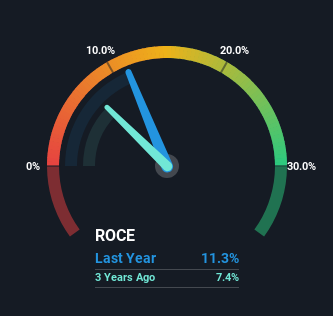Capital Allocation Trends At Rajshree Polypack (NSE:RPPL) Aren't Ideal
What trends should we look for it we want to identify stocks that can multiply in value over the long term? Ideally, a business will show two trends; firstly a growing return on capital employed (ROCE) and secondly, an increasing amount of capital employed. Put simply, these types of businesses are compounding machines, meaning they are continually reinvesting their earnings at ever-higher rates of return. However, after briefly looking over the numbers, we don't think Rajshree Polypack (NSE:RPPL) has the makings of a multi-bagger going forward, but let's have a look at why that may be.
What Is Return On Capital Employed (ROCE)?
If you haven't worked with ROCE before, it measures the 'return' (pre-tax profit) a company generates from capital employed in its business. The formula for this calculation on Rajshree Polypack is:
Return on Capital Employed = Earnings Before Interest and Tax (EBIT) ÷ (Total Assets - Current Liabilities)
0.11 = ₹189m ÷ (₹2.6b - ₹900m) (Based on the trailing twelve months to December 2023).
So, Rajshree Polypack has an ROCE of 11%. That's a relatively normal return on capital, and it's around the 13% generated by the Packaging industry.
See our latest analysis for Rajshree Polypack

Historical performance is a great place to start when researching a stock so above you can see the gauge for Rajshree Polypack's ROCE against it's prior returns. If you're interested in investigating Rajshree Polypack's past further, check out this free graph covering Rajshree Polypack's past earnings, revenue and cash flow.
What Can We Tell From Rajshree Polypack's ROCE Trend?
On the surface, the trend of ROCE at Rajshree Polypack doesn't inspire confidence. Over the last five years, returns on capital have decreased to 11% from 16% five years ago. However, given capital employed and revenue have both increased it appears that the business is currently pursuing growth, at the consequence of short term returns. And if the increased capital generates additional returns, the business, and thus shareholders, will benefit in the long run.
While on the subject, we noticed that the ratio of current liabilities to total assets has risen to 35%, which has impacted the ROCE. If current liabilities hadn't increased as much as they did, the ROCE could actually be even lower. While the ratio isn't currently too high, it's worth keeping an eye on this because if it gets particularly high, the business could then face some new elements of risk.
The Key Takeaway
Even though returns on capital have fallen in the short term, we find it promising that revenue and capital employed have both increased for Rajshree Polypack. And long term investors must be optimistic going forward because the stock has returned a huge 215% to shareholders in the last five years. So while the underlying trends could already be accounted for by investors, we still think this stock is worth looking into further.
Rajshree Polypack does come with some risks though, we found 4 warning signs in our investment analysis, and 2 of those are a bit concerning...
While Rajshree Polypack isn't earning the highest return, check out this free list of companies that are earning high returns on equity with solid balance sheets.
New: AI Stock Screener & Alerts
Our new AI Stock Screener scans the market every day to uncover opportunities.
• Dividend Powerhouses (3%+ Yield)
• Undervalued Small Caps with Insider Buying
• High growth Tech and AI Companies
Or build your own from over 50 metrics.
Have feedback on this article? Concerned about the content? Get in touch with us directly. Alternatively, email editorial-team (at) simplywallst.com.
This article by Simply Wall St is general in nature. We provide commentary based on historical data and analyst forecasts only using an unbiased methodology and our articles are not intended to be financial advice. It does not constitute a recommendation to buy or sell any stock, and does not take account of your objectives, or your financial situation. We aim to bring you long-term focused analysis driven by fundamental data. Note that our analysis may not factor in the latest price-sensitive company announcements or qualitative material. Simply Wall St has no position in any stocks mentioned.
About NSEI:RPPL
Rajshree Polypack
Manufactures and sells rigid plastic sheets and thermoformed packaging products in India and internationally.
Solid track record with mediocre balance sheet.
Similar Companies
Market Insights
Community Narratives



